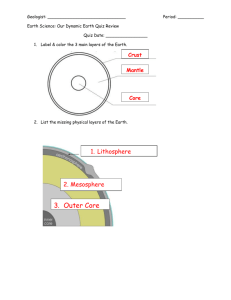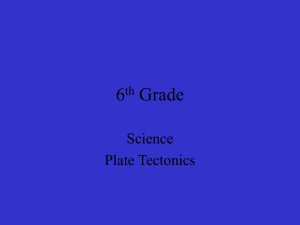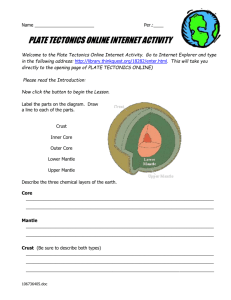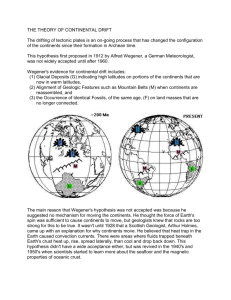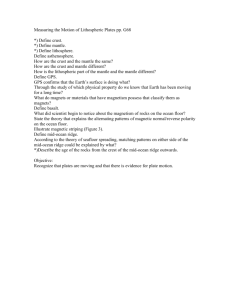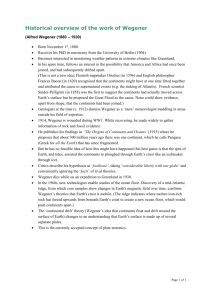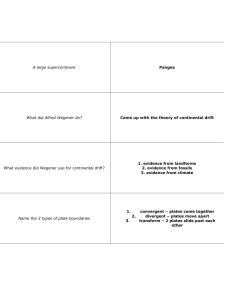Earth`s Interior Section 1
advertisement
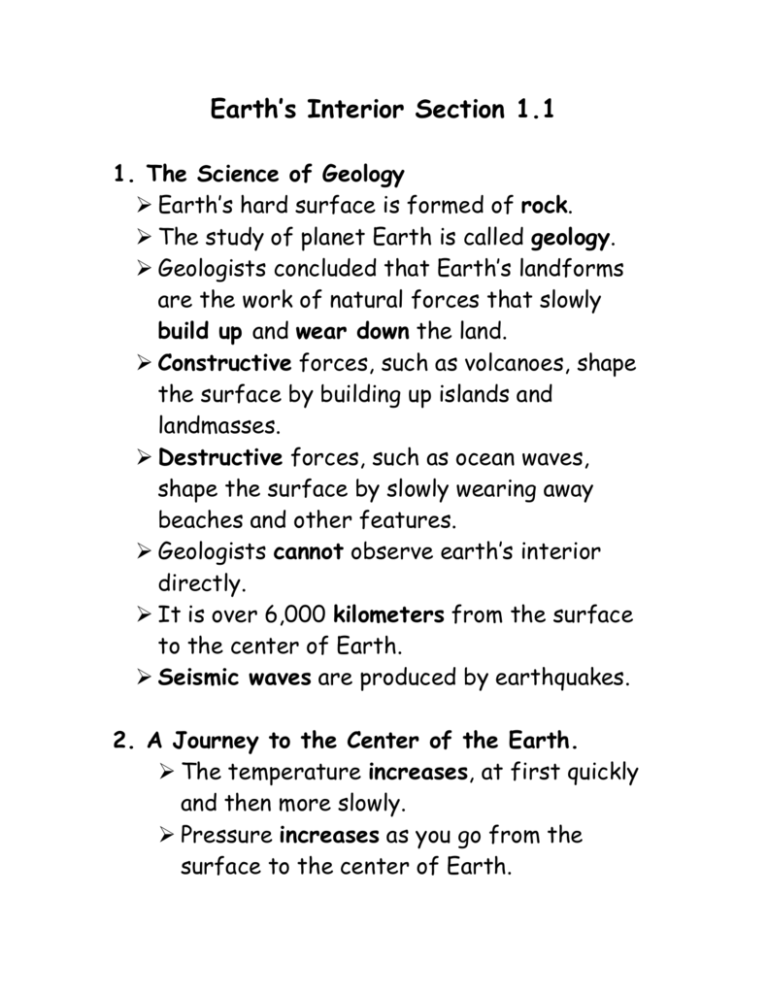
Earth’s Interior Section 1.1 1. The Science of Geology Earth’s hard surface is formed of rock. The study of planet Earth is called geology. Geologists concluded that Earth’s landforms are the work of natural forces that slowly build up and wear down the land. Constructive forces, such as volcanoes, shape the surface by building up islands and landmasses. Destructive forces, such as ocean waves, shape the surface by slowly wearing away beaches and other features. Geologists cannot observe earth’s interior directly. It is over 6,000 kilometers from the surface to the center of Earth. Seismic waves are produced by earthquakes. 2. A Journey to the Center of the Earth. The temperature increases, at first quickly and then more slowly. Pressure increases as you go from the surface to the center of Earth. The three main layers that make up the Earth’s interior are the crust, mantle and core. 3. The Crust The crust is a layer of rock that forms Earth’s outer skin. The dark-colored rock that makes up most of the oceanic crust is basalt. The light-colored rock that makes up most of the continental crust is granite. 4. The Mantle The mantle is a layer of hot rock between the crust and core. The lithosphere is a rigid layer that includes the upper part of the mantle and crust. The asthenosphere is a soft layer just below the lithosphere. 5. The Core The core contains iron and nickel. The core is under extreme pressure. 6. Earth’s Magnetic Field Currents in the liquid outer core force the inner core to spin. Earth’s magnetic field is created by the inner core spinning faster than the rest of Earth. Inside Earth 1.2 Convection Currents and the Mantle 1. Introduction The movement of energy form a warmer object to a cooler object is called heat transfer. Three types of heat transfer are radiation, conduction and convection. 2. Radiation Radiation is the transfer of energy through empty space. Forms of radiation include the heat you feel from sunlight and the heat you feel around a flame or open fire. 3. Conduction Conduction is heat transfer by direct contact of particles of matter. An example is a spoon heating up in a pot of hot soup or the skin of your hand heating up when you touch the hot spoon. 4. Convection Convection is the heat transfer by the movement of a heated fluid (liquid or gas). Heat transfer by convection is caused by differences of temperature and density within a fluid. A measure of how much mass there is in a volume of a substance is density. When a fluid’s temperature increases its density decreases. The currents will stop flowing when all the soup has reached the same temperature. 5. Convection in Earth’s Mantle Convection currents flow in the asthenosphere. The heat source for the convection currents is the Earth’s core. Drifting Continents 1. The Theory of Continental Drift Wegener’s hypothesis was that all the continents had once been joined together in a single landmass and have since drifted apart. Wegener named his supercontinent Pangaea. Wegener thought that this supercontinent had broken apart and that the pieces had slowly moved to become the continents as they are today. Wegener’s idea that the continents slowly moved over Earth’s surface became known as continental drift. Some examples that help prove this theory are the mountains in south Africa that line up with mountains in Argentina, and coal fields in Europe that match up with coal fields in North America. Any trace of an ancient organism preserved in rock is called a fossil. Wegener explained his finding similar fossils on different continents as evidence that the continents were at one time united. Wegener believed that the continents positions changed but not the Earth’s climate. 2. Scientists Reject Wegener’s Theory Wegener believed that mountains formed when continents collided with each causing the edges to crumple and fold. Mountains usually occur in narrow bands along the edges of continents, as you would expect if the collision of continents forms mountains. Sea-Floor Spreading Mapping The Mid-Ocean Ridge The mid-ocean ridge is the longest chain of mountains in the world The top of the mid-ocean ridge is split by a steep-sided valley A device that bounces sound waves off underwater objects is called sonar. Sonar is used to determine the distance to an object. It has been used to map the mid-ocean ridge. Evidence for Sea-Floor Spreading The process that continually adds new material to the ocean floor is called seafloor spreading. The three types of evidence for sea-floor spreading are molten material, magnetic stripes and drilling samples. At times in the past, a compass needle would have pointed south. Rock that makes up the ocean floor lies in a pattern of magnetized stripes. Rocks that harden at the same time have the same “magnetic memory.” The farther away form the ridge that the samples were taken, the older they are and the youngest samples were always in the center of the ridge. Subduction at Deep-Ocean Trenches Deep underwater canyons are called deepocean trenches. Subduction is the process by which the ocean floor sinks beneath a deep-ocean trench and back into the mantle. Subduction and Earth’s Oceans The Atlantic Ocean is expanding because it has only a few deep-ocean trenches, so the spreading ocean floor has virtually nowhere to go. The Theory of Plate Tectonics Introduction The lithosphere is broken into separate sections called plates. A Theory of Plate Motion A scientific theory is a well-tested concept that explains a wide range of observations. Pieces of Earth’s lithosphere are in constant, slow motion, driven by convection in the mantle. Plate Boundaries Plate boundaries are lines where different pieces of the lithosphere meet. A fault is a break in Earth’s crust where rocks have slipped past each other. Rift valleys are deep valleys that form where two plates pull apart. Most divergent boundaries occur at the mid-ocean ridge. When two plates converge, the result is called a collision The density of the plates determines which plate comes out on top. The Continents’ Slow Dance Plates move from about one to ten centimeters per year.

